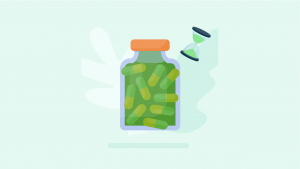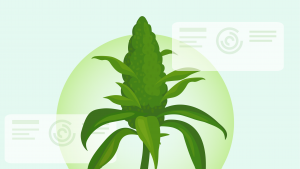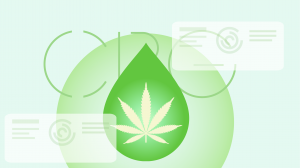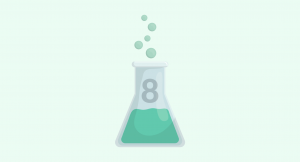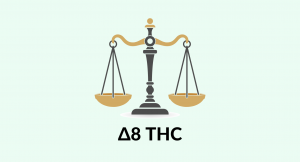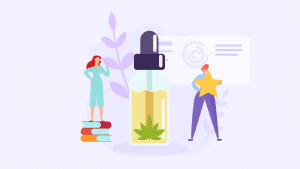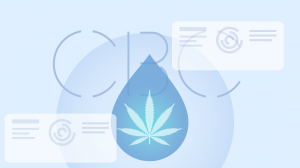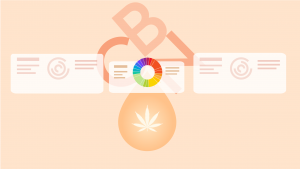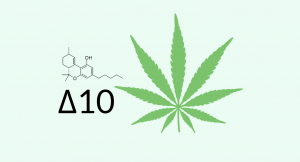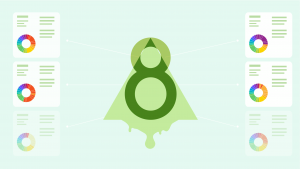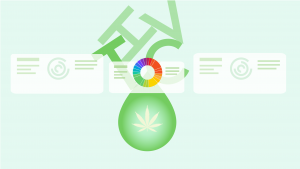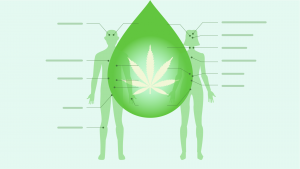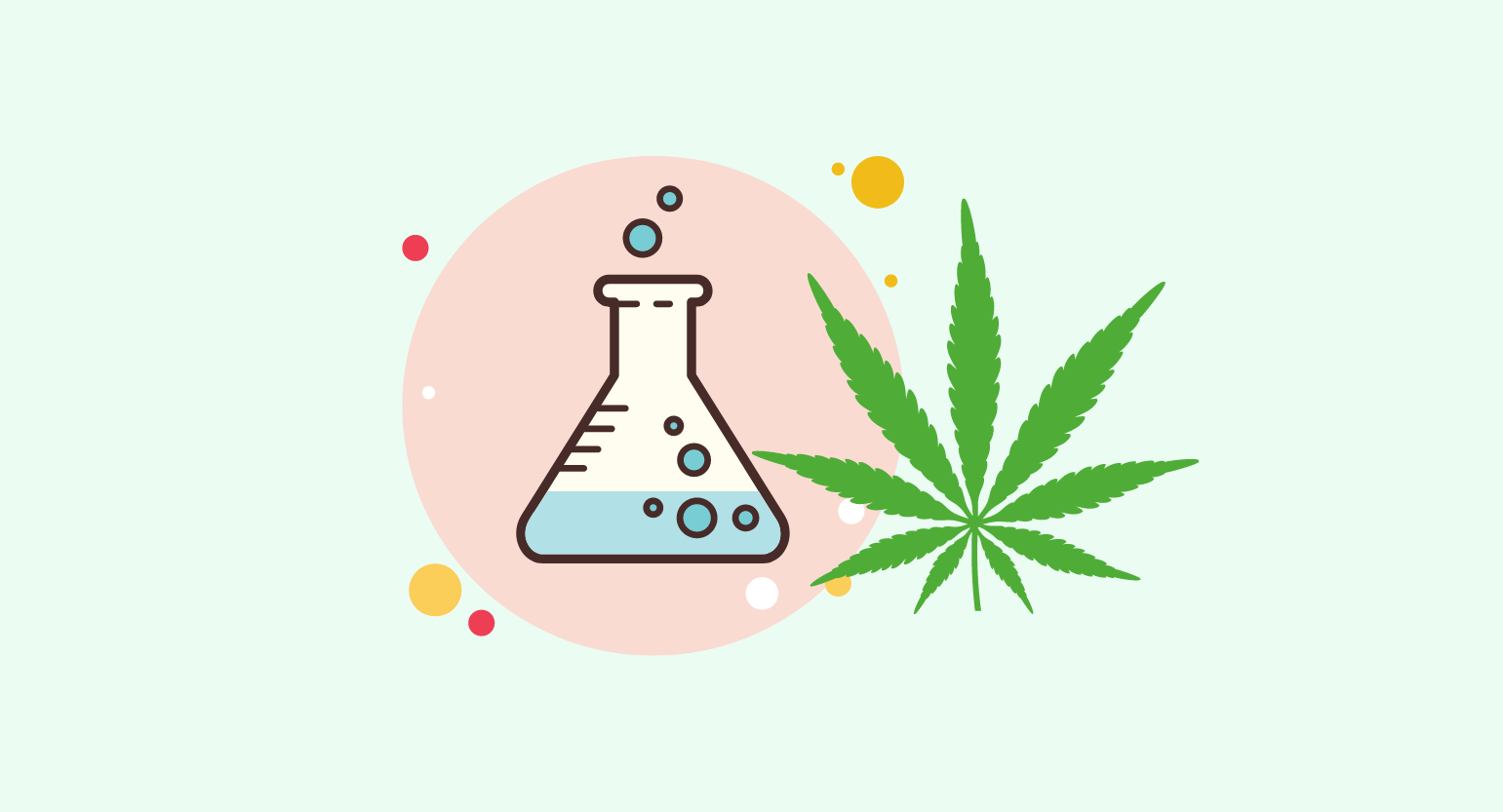
Evidence based
What Are Synthetic Cannabinoids? What Makes Them So Dangerous?
Synthetic cannabinoids are human-made chemicals that look or act like naturally occurring cannabinoids.
THC and CBD are the two most well-known cannabinoids — but there are over 100 others produced in cannabis plants alone. There are also several hundred man-made versions (and counting).
Synthetic cannabinoids are molecules that interact with the endocannabinoid system or share key structural similarities with THC. Most (but not all) are psychoactive. Some, such as THC-O-acetate, are substantially stronger than natural THC.
In this guide, we’ll cover everything you need to know about synthetic cannabinoids and synthetic weed. We’ll also discuss the potential risks of using synthetic weed products like K2 or Spice.
What is a Synthetic Cannabinoid?
Synthetic cannabinoids are compounds that share similar properties to cannabinoids like THC or CBD but are entirely man-made. This doesn’t include naturally occurring isomers of THC like delta 7 THC, delta 8 THC, or delta 10 THC.
Most synthetic cannabinoids are agonists of the endocannabinoid system. They’re designed to mimic the effects of THC in order to induce a similar high users feel after smoking marijuana.
There are hundreds of individual compounds classified as synthetic THC or synthetic CBD — the vast majority of which have never been assessed for safety. There are reports of people experiencing severe and unpredictable physical or psychological side effects after using synthetic weed products like K2 or Spice.
Naturally-occurring forms of THC are extremely unlikely to lead to addiction or overdose — and there’s a ton of scientific research to back this up.
We can’t say the same about synthetic cannabinoids. All of them activate the ECS in some way, but many affect other receptor types as well — such as NMDA, GABA, dopamine, serotonin, or opiate receptors.
When a substance targets multiple separate receptors, they’re referred to as “dirty drugs.” They can lead to any number of undesirable or unexpected side effects as a result.
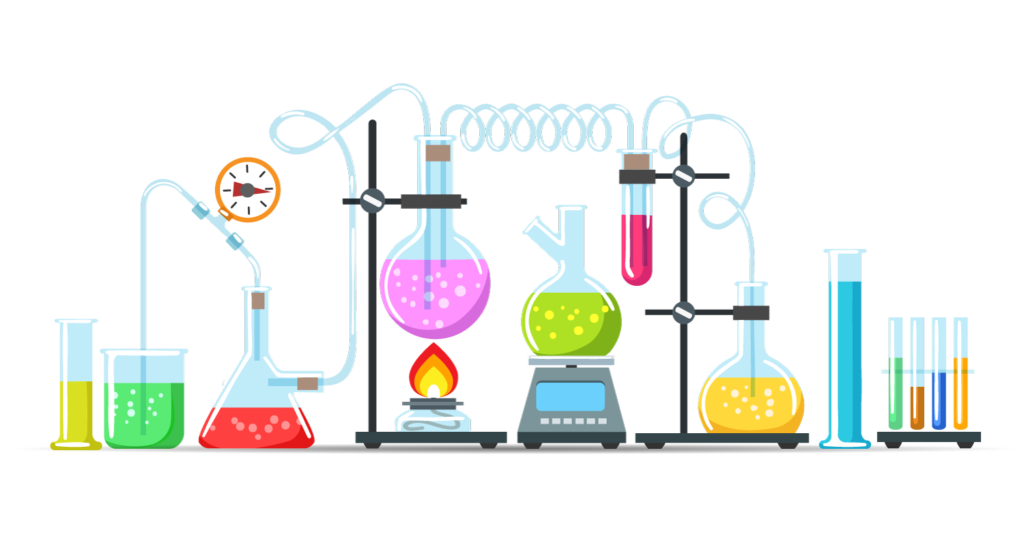
Are Synthetic Cannabinoids Legal?
Today, synthetic cannabinoids are illegal in most parts of the world, including the US, Canada, the UK, and Australia.
But it hasn’t always been this way.
Synthetic cannabinoids used to be legal in many countries. They were sold as “incense” or legal highs in places where marijuana products were illegal.
These compounds are sold under many different names, but the most pervasive is K2 or Spice, which used to be available in headshops and online stores. They often featured colorful packaging and had all kinds of catchy names, such as Joker, Black Mamba, Kush, or Kronic.
After many reports of people experiencing lasting physical or psychological side effects from synthetic cannabinoids, governments started banning them. The problem was that as soon as the government would ban a particular molecule, manufacturers would invent and market another one that side-stepped the new regulation.
This was an ongoing game of cat and mouse between regulators and synthetic cannabis labs until eventually, the US federal government introduced a new law that made any New Psychoactive Substances (NPS) illegal. This ruling essentially makes all substances that have any psychoactive effect illegal by default. Only after careful analysis would a newly-formed psychoactive substance become legal — rather than the other way around.
A few prescription-only medications classified as synthetic cannabinoids that have gone through this process — such as Nabilone, Marinol (Dronabinol), and Dexanabinol Cannabinor, and CT-3.
The Blackmarket Spice Trade
Banning Spice didn’t fix the problem — it actually made it much worse.
As with any illegal drug, manufacturers were motivated to make new versions that are stronger than ever before. The market moved from a grey-area head shop business to the black market.
The Spice that started appearing on the streets about a year after it was initially banned was an entirely different beast. It was much more addictive, much stronger, and much more dangerous.
There are millions of people now addicted to Spice, some of which transitioned from using highly addictive drugs like heroin to Spice instead.
What could possibly be in this stuff?
What is K2 or Spice?
Synthetic marijuana products (AKA Spice or K2) are made by spraying any number of synthetic cannabinoids or other chemicals onto dried leaf matter (usually rosehip, nettle leaf, alfalfa, or others). People then smoke the leaves the same way they would for marijuana products.
These products rarely name what was in them. Most were a combination of several ingredients that were completely untested. Harmful chemicals were even found in some samples in the US, including pharmaceutical medications like benzodiazepines or opiates.
Prior to the NPS ban, Spice was made exclusively with synthetic cannabinoids. Now, it could contain just about anything.
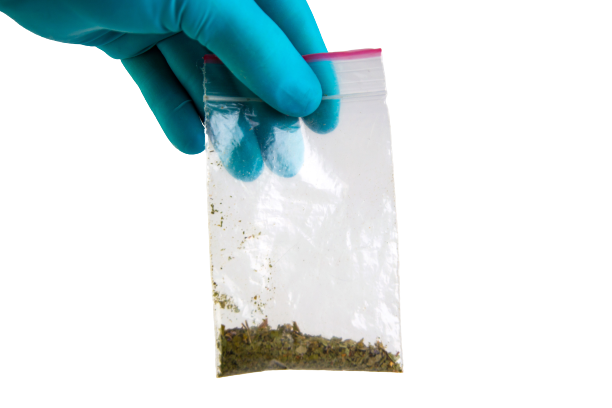
Are Synthetic Cannabinoids Dangerous?
Yes, there have been deaths associated with synthetic cannabinoid use. Aside from the approved pharmaceutical products, there has yet to be any official research on synthetic cannabinoids. They’re considered research chemicals because little is known about their effects or safety profiles.
There have also been countless reports of users experiencing both behavioral and physical addiction to these various synthetic cannabinoids — sometimes even after just a few weeks of use.
Not all synthetic cannabinoids are inherently dangerous or addictive [1], but without proper testing, it’s nearly impossible to know which products are going to cause serious side effects, addiction, or death. To make matters worse, most synthetic marijuana products contain a variety of these compounds — none of which are listed on the label.
The addition of other ingredients like benzos, opiates, or other drugs also brings a great deal of risk when using these products.
Some of the side-effects reported among people who have used synthetic cannabinoids include:
- High blood pressure
- Rapid heart rate
- Altered perception
- Suicidal thoughts
- Vomiting
- Violent behavior
- Psychosis or delirium
- Heart arrhythmias
- Kidney damage
- Seizures
There Have Been Deaths Reported From Synthetic Cannabis Consumption
Some synthetic cannabinoids are as much as 100 times stronger than naturally occurring cannabinoids.
It’s common for people to take far too much of these substances — leading to overdose.
Granted, most of the overdose deaths from these products were driven by dangerous adulterants like opiates or benzodiazepines as well.
A common phenomenon among spice overdose cases is that they tend to appear in waves. This suggests there are certain batches that have a particularly high incidence of harm.
For example, in May 2018, nearly 100 people died, and hundreds of others suffered severe side effects after smoking Spice. Later that same year, 56 people overdosed in Brooklyn, New York, and another 40 in Dallas, Texas
Types of Synthetic Cannabinoids
There are three main types of synthetic cannabinoids.
Some have the exact same structure of THC or other cannabinoids produced by the hemp plant (classical cannabinoids); others mimic the shape and structure of our endocannabinoids produced by the body instead (eicosanoids).
The final group shares nothing in common with either class but binds to the same receptors (non-classical cannabinoids).
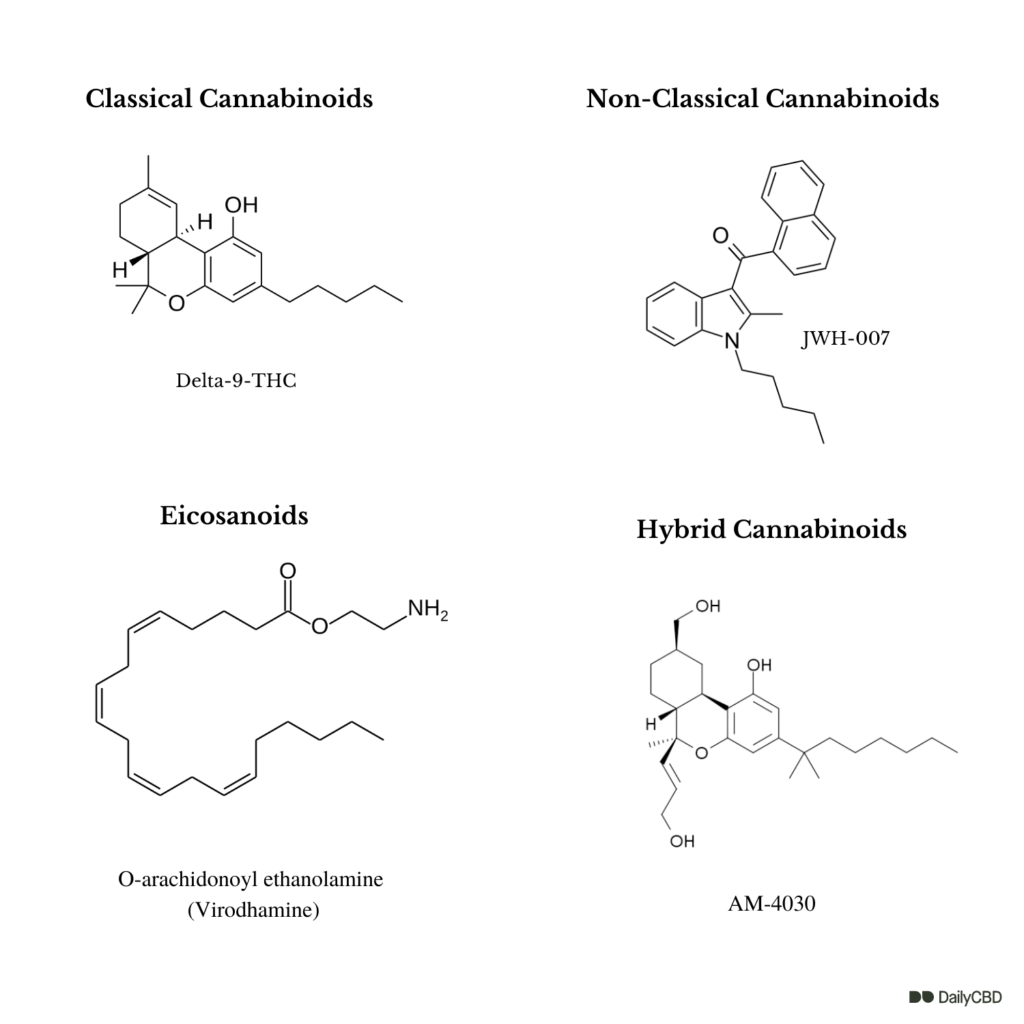
1. Classical Cannabinoids
Classical cannabinoids refer to the compounds naturally produced by the plant or synthetic isomers of these molecules. They have the same general shape and structure as phytocannabinoids like THC or CBD.
The technical definition of a classical cannabinoid is any natural or synthetic ABC-tricyclics incorporating a benzopyran moiety [2]. They’re composed of two parts — an aromatic part and an alicyclic part.
Synthetic Classical Cannabinoids Include:
- HU-210
- 9-Ketocannabinoid (Nabilone)
- AM-2389
- AM-993
- AM-994
- AM-7499
- THC-O-Acetate

2. Synthetic Eicosanoids
The human body makes its own cannabinoids to interact with the endocannabinoid system. These compounds are classified as eicosanoids. An eicosanoid is a large group of signaling molecules similar to hormones or neurotransmitters that are made from arachidonic acid.
There are several synthetic eicosanoids that have been developed that can interact with the endocannabinoid system, including synthetic versions of naturally occurring endocannabinoids.
Eicosanoids Include:
- N-arachidonoylethanolamine — anandamide (AEA)
- 2-arachidonoylglycerol (2-AG)
- N-arachidonoyl dopamine (NADA)
- O-arachidonoyl ethanolamine (Virodhamine)

3. Non-Classical Cannabinoids
Once we step into the realm of non-classical cannabinoids, the possibilities are virtually endless. The most common street versions of synthetic cannabinoids are the non-classical cannabinoids.
This class refers to any compounds that interact with the endocannabinoid system that lacks the benzopyran ring of the classical cannabinoids [3]. They have many of the same properties as cannabinoids like THC but have a completely different chemical structure.
Pfizer developed the first synthetic non-classical cannabinoids in the 1970s. They developed a series of AC-bicyclic and ACD-tricyclic cannabinoids such as CP-47,497.
CBD is technically a non-classical cannabinoid because it lacks a benzopyran ring in its chemical structure.
There Are Several Classes of Non-Classical Cannabinoids:
- Naphthoylindoles — JWH-007, JWH-018, JWH-073, JWH-200, JWH-398, AM-1221, AM-2201, AM-694, WIN-55,212-2
- Phenylacetylindoles — JWH-250, RCS-8
- Cyclohexylphenols — CP-47,947, CP-55,940
- Benzoylindoles — AM-2233
- Tetramethylcyclopropylindoles — UR-144, XLR-11
- Adamantoylindoles — 5F-AKB-48, APICA, STS-135
- Indazole carboxamides — AB-PINACA, AB-FUBINACA
- Quinolinyl ester — PB-22, 5F-PB-22

4. Hybrid Cannabinoids
Hybrid cannabinoids are derived from aspects of classical and non-classical cannabinoids. The first hybrid cannabinoid was found in 1994 by Makriyannis and Tius.
Since then, pharmaceutical companies including Sanofi and Sterling-Winthrop have developed other hybrids — some of which are currently being explored for their medicinal value.
Hybrid Cannabinoids Include:
- Diarylpyrazoles — SR-141716A, SR-144528
- Aminoalkylindoles — WIN-55,212-2
- HU-210 Derivatives — AM-4030

Prescription-Only Synthetic Cannabinoids
Most of the pharmaceutical cannabinoid medications on the market today are synthetic. The only pharmaceutical preparation approved for medical use that’s derived directly from marijuana plants is Sativex®.
- Cesamet® (Nabilone) — Classical cannabinoid
- Epidiolex® (Cannabidiol)— Non-classical cannabinoid
- Dexanabinol® (HU-211) — Hybrid cannabinoid
- Dronabinol® (trans-Δ9-tetrahydrocannabinol) — Classical cannabinoid
- Cannabinor® (PRS-211,375) — Non-classical cannabinoid
- CT-3 (ajulemic acid) — Classical cannabinoid
- Taranabant (MK-0364) — Non-classical cannabinoid
Is Delta 8 THC A Synthetic Cannabinoid?
The short answer is no; delta 8 THC is not a synthetic cannabinoid because it occurs naturally in the cannabis plant.
However, delta 8 THC products aren’t made by extracting it from cannabis plants directly because it doesn’t appear in concentrations high enough for this to be viable. You would need to process a field of hemp to obtain even a single dose of delta 8 THC.
So instead, companies convert more common cannabinoids like CBD into the delta 8 THC isomer.
While this process itself is “synthetic” and requires laboratory equipment, it’s a far cry from what we’re talking about in regards to synthetic cannabinoids here. Instead, this process is classified as “naturally-derived.” It involves converting one naturally occurring substance (CBD) into another naturally occurring substance (delta 8 THC).
To nobody’s surprise, delta 8 THC has never been associated with any of the detrimental effects associated with true synthetic cannabinoids.
Related: How to convert CBD to delta 8 THC.
Summary: What Are Synthetic Cannabinoids?
Synthetic cannabinoids are any man-made substances that either look or act like naturally ocurring cannabinoids.
There are four main classes of synthetic cannabinoids — the classical cannabinoids, non-classical cannabinoids, hybrid cannabinoids, and eicosanoids.
Naturally occurring cannabinoids, such as THC or CBD aren’t considered “synthetic cannabinoids.” This term refers specifically to cannabinoids not found in nature.
This class of cannabinoids is very large and diverse — and little is known about the medicinal value, effect profile, or safety of most synthetic cannabinoids. As a result of numerous issues with side effects and even death, all synthetic cannabinoids are considered illegal unless proven safe.
Due to safety concerns, we suggest you stick to the natural stuff. THC, CBD, CBC, and other phytocannabinoids already have proven safety records and have a long history of use.
References
- Ware, M. A., & St Arnaud‐Trempe, E. (2010). The abuse potential of the synthetic cannabinoid nabilone. Addiction, 105(3), 494-503.
- Mechoulam, R., Braun, P., & Gaoni, Y. (1967). Stereospecific synthesis of (-)-. DELTA. 1-and (-)-. DELTA. 1 (6)-tetrahydrocannabinols. Journal of the American Chemical Society, 89(17), 4552-4554.
- Ho, T. C., & Tius, M. A. (2019). Synthesis of Classical/Nonclassical Hybrid Cannabinoids and Related Compounds. In Cutting-Edge Organic Synthesis and Chemical Biology of Bioactive Molecules (pp. 247-289). Springer, Singapore.

